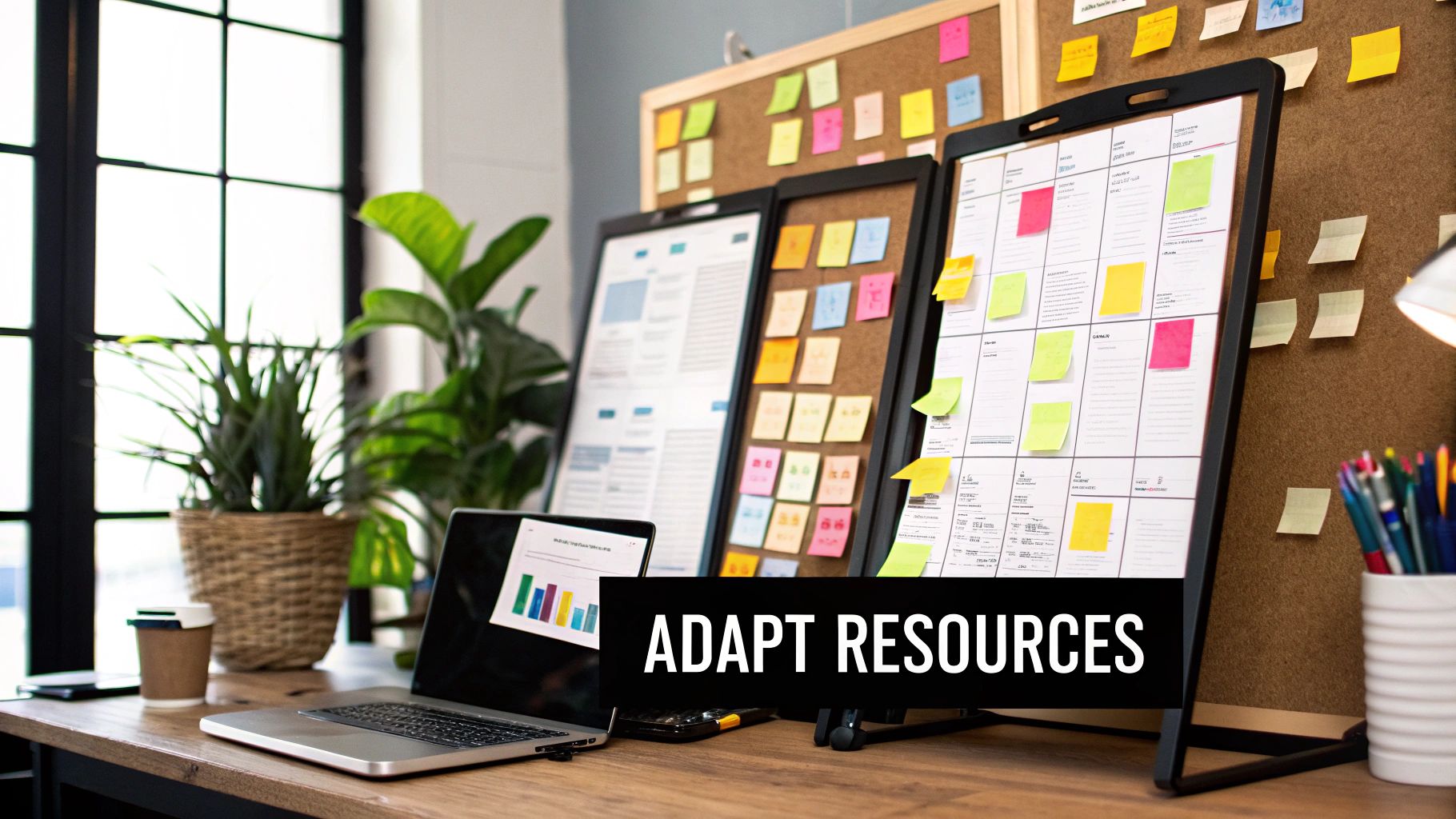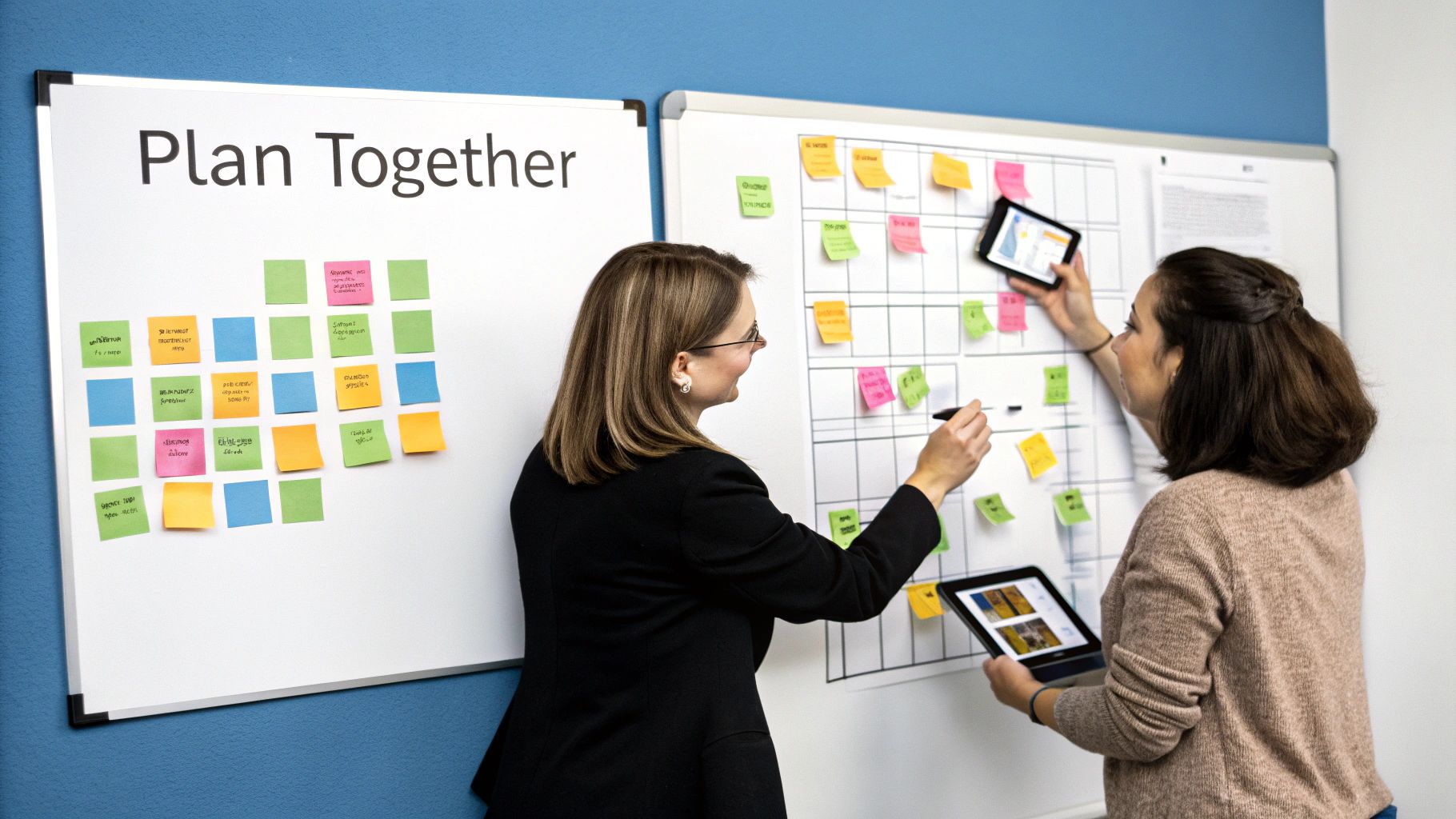Understanding What Makes Creative Resource Management Work

Creative resource management is more than just a popular term. It's the foundation of successful creative teams, blending strategy and organization to manage talent, time, and resources effectively. The goal? Delivering exceptional creative work on time and within budget. This involves a shift from simply managing individual projects to optimizing the whole creative process.
Why Traditional Project Management Falls Short
Traditional project management methods, often rigid in structure, can struggle in the dynamic world of creative work. Creativity thrives on iteration and flexibility. Imagine trying to confine a brainstorming session to a strict schedule! This can stifle innovative thinking and lead to less effective results.
Traditional approaches also often overlook the unique skills and varying workloads of creative individuals. This can result in misallocated resources, creating bottlenecks and ultimately, team burnout.
The Core Principles of Effective Creative Resource Management
Effective creative resource management relies on three key principles: capacity planning, skill mapping, and workflow optimization. Capacity planning anticipates the natural ebb and flow of creative projects and includes buffer time for revisions and unexpected requests.
Skill mapping goes beyond basic job titles to identify each team member's strengths and weaknesses. This allows for more strategic project assignments, ensuring the right people are working on the right tasks. Workflow optimization streamlines the creative process without hindering the flow of ideas, guiding projects smoothly from initial concept to final delivery. The creative management platforms market is seeing significant growth, reflecting the growing need for specialized solutions in this area.
Identifying and Addressing Resource Bottlenecks
A vital aspect of creative resource management is proactively identifying and addressing resource bottlenecks. These bottlenecks, like an overloaded key team member or limited access to essential software like Adobe Photoshop, can disrupt project timelines and lead to missed deadlines.
By carefully monitoring resource allocation and project progress, creative managers can identify potential bottlenecks early. For example, a designer consistently assigned to multiple projects simultaneously could become a bottleneck for several teams. Addressing these issues proactively, perhaps by redistributing tasks or bringing in additional support, is crucial for a smooth and efficient creative workflow. For more on managing freelance projects, check out this resource: 7 Freelance Project Management Tools to Ace 2025.
Building a Sustainable Creative Operation
The ultimate goal of creative resource management is to build a sustainable creative operation capable of scaling with your business. This involves creating a system that supports both the creative needs of your team and the business objectives of your organization.
It's about fostering an environment where creativity flourishes, while ensuring projects are delivered on time and within budget. This approach leads to increased productivity, higher team morale, and ultimately, better creative output.
Building Workflows That Actually Work For Creative Minds
Forget rigid processes that stifle inspiration. This section explores how to build workflows that actually enhance creativity. We'll examine how leading creative teams structure their operations to maximize both innovation and efficiency, avoiding unnecessary bureaucracy.
Frameworks for Managing Creative Projects
Successful agencies often use specific frameworks to manage projects, from initial brainstorming to final delivery. These frameworks serve as a roadmap, guiding the team through each stage while still allowing for the flexibility that is essential to creative work. Think of it like jazz improvisation: there's structure (the chord progression), but within that structure, there's room for individual expression and spontaneity.
-
Stage-Gate Process: This process breaks a project down into distinct stages, each with specific goals and deliverables. At the end of each stage ("gate"), the project is reviewed before moving to the next. This ensures quality control without hindering the creative flow.
-
Collaborative Review Cycles: Feedback is crucial for creative work, but endless revisions can be demoralizing. Structured, collaborative review cycles with clear guidelines and timelines keep the process moving forward productively.
-
Quality Checkpoints: Strategic quality checkpoints throughout the workflow help catch potential issues early on. This is much more efficient than discovering problems at the last minute.
To illustrate the benefits of a structured approach, let’s look at a comparison of traditional and optimized creative workflows. The following table highlights the time savings and quality impact achievable through optimization:
| Workflow Stage | Traditional Approach | Optimized Approach | Time Saved | Quality Impact |
|---|---|---|---|---|
| Brainstorming | 2 days | 1 day | 1 day | Increased focus |
| Concept Development | 3 days | 2 days | 1 day | Enhanced collaboration |
| Design & Production | 5 days | 4 days | 1 day | Reduced errors |
| Review & Revision | 3 days | 2 days | 1 day | More effective feedback |
| Finalization & Delivery | 2 days | 1 day | 1 day | Smoother handover |
| Total | 15 days | 10 days | 5 days | Improved overall quality |
Creative Workflow Stage Comparison: Comparison of traditional vs. optimized creative workflow stages showing time allocation and efficiency metrics
As the table demonstrates, an optimized workflow can lead to significant time savings—in this example, 5 days, or a 33% reduction in project duration. This translates to increased efficiency and faster turnaround times without compromising quality. In fact, a structured approach often improves quality by reducing errors and streamlining the feedback process.
Eliminating Bottlenecks in Creative Workflows
Bottlenecks, like unclear feedback or constant revisions, can frustrate creative teams and derail projects. Let’s examine ways to eliminate these common roadblocks:
-
Clear Communication: Establish clear communication channels and protocols from the start. This keeps everyone on the same page and minimizes the chance of misunderstandings. Tools like Slack can facilitate real-time communication and project updates.
-
Defined Scope: A well-defined project scope prevents scope creep, which is the expansion of a project beyond its original parameters. Clear scope definition protects both the team and the client.
-
Streamlined Feedback: Implement a system for giving and receiving feedback that is efficient and constructive. This might involve using project management software like Asana or dedicated feedback tools.
Balancing Structure with Flexibility
Creative resource management is about striking the right balance between structure and flexibility. Too much structure, and you risk stifling creativity. Too little, and you lose control of the process. It's about empowering your team to maintain their creative spark while consistently meeting deadlines and exceeding client expectations.
Getting The Most From Your Creative Team Through Smart Resource Planning

Stop relying on chance for resource allocation. Instead, adopt a strategic approach to assigning tasks and managing your team's time. This involves carefully matching individuals to projects that best suit their skills and working styles, ultimately boosting both individual and team performance.
Matching People to Projects: The Foundation of Creative Resource Management
Effective creative resource management begins with understanding your team's strengths. Don't just assign tasks based on job titles. Look deeper to identify individual skills and use those skills strategically.
For instance, assigning a designer with strong illustration skills to a project requiring custom graphics is a simple yet effective way to apply this principle.
Also, consider individual work styles and preferences. Some team members thrive in collaborative settings, while others prefer focused, individual work. Factoring these preferences into project assignments can lead to greater job satisfaction and higher quality work. You might be interested in: How to manage creative projects for success.
Capacity Planning: Accounting for the Unpredictable
Creative work rarely follows a straight line. It involves exploration, experimentation, and often, several revisions. This means capacity planning must be adaptable enough to handle the unpredictable nature of creative processes.
Incorporate realistic buffer time for revisions, client feedback, and those inevitable last-minute adjustments.
Simply adding random buffer time isn't sufficient, though. Effective capacity planning requires data. Tracking the typical duration of different tasks enables more accurate project timelines. This data-driven approach promotes realistic scheduling and minimizes the chance of budget overruns or missed deadlines.
Cross-Training and Flexibility in Creative Teams
Cross-training team members enhances flexibility and team resilience. This means equipping individuals with skills beyond their primary specialization, allowing them to contribute to a broader range of projects. For instance, a graphic designer learning basic video editing can offer valuable support during peak times.
However, cross-training should be implemented strategically. The goal is to expand skill sets thoughtfully, not to create generalists lacking specialized expertise. Creative agencies are increasingly using project management software like Asana to streamline processes and enhance collaboration. 77% of high-performing teams utilize such tools. These platforms often offer features tailored to creative professionals, including asset management, proofing and approvals, and resource scheduling. Find more detailed statistics here
Preventing Burnout and Maintaining Quality
Burnout can stifle creativity. Effective resource management includes proactively preventing burnout by monitoring workloads, ensuring sufficient time off, and cultivating a supportive work environment. Recognizing early warning signs of burnout, such as decreased productivity, increased negativity, and disengagement, allows for timely intervention and support.
Maintaining consistent quality output, even during busy periods, requires careful resource allocation and clearly defined priorities. This includes ensuring team members have the necessary resources and aren't overwhelmed by conflicting demands. Effective creative resource management needs well-defined processes, so check out this article on how to streamline your video creation workflow. By prioritizing these aspects of creative resource management, you can empower your team to consistently deliver their best work.
Choosing The Right Technology Stack For Your Creative Operations

This infographic highlights key metrics in creative resource management. It shows the average number of monitoring metrics tracked per project, how often resources are reallocated monthly, and the average efficiency improvement. The data reveals a clear connection: tracking project metrics and regularly adjusting resources significantly boosts efficiency. This emphasizes the importance of data-driven decisions in managing creative resources. When selecting your tech stack, explore available resources, such as those found at: Tools. The right choices can streamline your workflow and maximize your creative impact. For further insights, check out this resource on top creative project management software.
Key Considerations When Evaluating Technology
Choosing the right tools involves more than just being impressed by a demo. It's about finding features that truly address your team's needs and challenges.
For instance, if version control is a struggle, a platform with strong versioning is essential. Think about the total cost, not just the initial price. Include training, implementation, and integration expenses in your budget.
Creative Management Platforms vs. Specialized Tools
Creative management platforms (CMPs) provide a central hub for managing the entire creative process, from initial briefs to final delivery. They often combine project management, asset management, and team collaboration features. Specialized tools, conversely, focus on specific tasks like proofing, feedback, or resource scheduling.
Choosing between a CMP and individual tools depends on your team’s size, budget, and workflow complexity. Smaller teams may find specialized tools more flexible and cost-effective. Larger teams might benefit from a CMP's comprehensive approach. Consider the market growth in the marketing resource management sector, projected to rise from $6.2 billion in 2024 to $7.17 billion in 2025. This suggests a growing trend towards dedicated resource management solutions. Learn more about marketing resource management.
The following table provides a comparison of different Creative Management Platforms.
Creative Management Platform Features Matrix
Comprehensive comparison of key features across different creative management platform categories.
| Feature Category | Basic Platforms | Professional Platforms | Enterprise Solutions | ROI Impact |
|---|---|---|---|---|
| Project Management | Basic task management, Kanban boards | Customizable workflows, Gantt charts, resource allocation | Portfolio management, demand planning, cross-project reporting | Improved project delivery times, reduced project costs |
| Asset Management | File storage, basic versioning | Metadata tagging, advanced search, access controls | Digital asset library, brand guidelines, automated workflows | Increased asset utilization, reduced asset creation costs |
| Team Collaboration | Basic communication tools, file sharing | Real-time feedback, online proofing, task assignments | Customizable dashboards, advanced reporting, integrations with other enterprise systems | Improved team communication, increased productivity |
This table summarizes the key features and ROI impact of different creative management platform categories. Choosing the right platform can significantly impact your team's efficiency and overall success.
Successful Technology Implementation Strategies
New technology should enhance your workflow, not disrupt it. Start with a pilot program involving a small group of users. This helps identify issues and gather feedback before a full launch. Provide adequate training and support to ensure team members understand the tool's benefits and how to use it effectively.
Calculating ROI and Avoiding Pitfalls
The real ROI of technology extends beyond cost savings. It includes increased productivity, improved collaboration, and better creative output. For example, tools that streamline feedback can reduce revision time, allowing your team to focus on more strategic tasks.
Finally, beware of excessive features. Many platforms offer a vast array of options, but not all will be relevant to your needs. Overly complex software can overwhelm your team, leading to low adoption rates and wasted investment. Choosing the right technology is crucial for effective creative resource management. This empowers teams to produce excellent work while maximizing their resources.
Measuring What Matters For Creative Resource Performance

Optimizing your creative resource management requires moving past gut feelings and embracing data-driven decisions. This means identifying Key Performance Indicators (KPIs) that genuinely reflect success and using them to inform your strategies. This section explores the essential metrics to track, showing you how to leverage data to refine resource allocation and boost team performance. Interested in more tips? Check out this article on How to master creative team management for peak performance.
Key Performance Indicators for Creative Teams
While surface-level metrics like social media engagement can be appealing, they often don't reveal the true effectiveness of your creative resource management. Instead, concentrate on metrics directly linked to your business objectives.
-
Utilization Rates: Keep track of both total utilization (time spent working) and billable utilization (time spent on client-billable projects). The goal is to maximize billable utilization, ensuring your team's efforts are focused on revenue-generating activities. A high billable utilization rate is a major contributor to profitability.
-
Project Profitability: Evaluate the financial outcome of each project. Calculate the actual cost, including all resources, and compare it against the revenue generated. This highlights areas where you can improve efficiency.
-
Team Satisfaction Scores: A happy creative team is a productive one. Regularly assess team morale through surveys or feedback sessions to uncover potential issues impacting performance, like burnout or inefficient processes. Addressing these can boost productivity and reduce turnover.
-
Client Retention Metrics: Client retention speaks volumes about the quality and impact of your creative work. Track retention rates and gather feedback to understand client satisfaction and identify areas for improvement.
Establishing Baselines and Tracking Progress
To use KPIs effectively, establish realistic baselines. These initial measurements serve as a benchmark against which to measure future progress. Track your chosen KPIs over time to establish a typical performance level.
For instance, if your average billable utilization rate is currently 60%, a baseline allows you to track improvements and understand the factors influencing them. You can then adjust resource allocation strategies and observe their impact.
Gathering and Acting on Feedback
Data alone isn't enough. Gathering qualitative feedback from both your team and clients adds essential context and insights. This might involve regular feedback sessions with your team, client surveys, or post-project reviews.
Honest feedback can reveal hidden pain points and opportunities for improvement, providing data-backed, actionable insights. For example, team feedback might highlight inefficient review processes as a roadblock to productivity.
Identifying Improvement Opportunities and Implementing Change
Data combined with feedback creates a powerful tool for identifying areas where your creative resource management can be optimized. This could involve streamlining your workflow, investing in new technologies, or adjusting your resource allocation. Remember, creative resource management is an ongoing process of refinement.
Once changes are implemented, continuously monitor your KPIs to measure their impact. This iterative approach ensures you're consistently refining your strategies for maximum effectiveness, enhancing both efficiency and the creative output of your team.
Scaling Your Creative Operations Without Losing What Makes You Great
Growth is exciting. But scaling a creative team can be tricky. Expanding without a solid plan risks losing the special ingredients that made you successful in the first place: collaboration, innovation, and high-quality work. This section explores how to scale sustainably, keeping your team’s unique magic while meeting increasing demands. You might be interested in: How to master creative operations management to drive effective results.
Maintaining Creative Culture During Growth
As your team grows, maintaining a thriving creative culture is crucial. New hires should add to, not detract from, the collaborative environment. Onboarding should emphasize not only technical skills but also the shared values and collaborative spirit that define your team.
For example, pair new hires with seasoned team members as mentors. This ensures they're quickly integrated into the creative environment. This mentorship program can significantly impact how quickly new team members understand and embrace your company's culture.
Building Scalable Processes
Effective scaling requires adaptable processes. This doesn't mean rigid, creativity-stifling rules. Instead, focus on flexible frameworks that provide structure without hindering innovation.
Think of it as a modular system. Individual components (processes) can be easily added, removed, or adjusted as needed to accommodate changing business demands. This flexibility is key to remaining agile and responsive in a dynamic market.
Anticipating Resource Management Challenges
Growth often brings resource allocation challenges. Larger projects, increased clients, and expanding service offerings require proactive resource planning. By anticipating these challenges, you can avoid overworking your team and compromising quality.
Understanding market trends is also crucial. For example, by 2026, the creative agency software market is expected to reach $1.48 billion. This highlights the growing need for efficient resource management in the creative industry. Learn more here: Creative Agency Software Market Growth. Using tools like Asana can help manage these resources effectively.
Preserving Quality Standards as You Scale
Maintaining quality during rapid growth demands a proactive strategy. Implement quality control measures throughout the creative process. This could include setting clear quality standards for deliverables, implementing structured review cycles, and using project management tools to track progress and identify potential issues early. Early identification allows for timely adjustments and prevents small issues from becoming major roadblocks.
Nurturing Client Relationships Through Transitions
Growth can sometimes disrupt existing client relationships. Open communication is vital during these transitions. Keep clients informed of changes, reassure them of your ongoing commitment, and ensure a seamless handover if new team members are involved. This maintains trust and reinforces the value you place on their partnership.
Ensuring Positive Cultural Evolution
As your team grows, your culture will naturally change. The key is to guide this evolution in a positive direction. Regularly seek feedback from team members, address concerns promptly, and ensure your core values remain central. This creates a sense of ownership and ensures everyone feels valued during the expansion. This proactive approach prevents cultural dilution and helps your creative team thrive through periods of rapid growth.
Ready to empower your creative team and unlock their full potential? Creativize connects you with top local talent, providing the resources you need to scale your creative operations effectively. Visit Creativize today and discover the power of local creative expertise!

